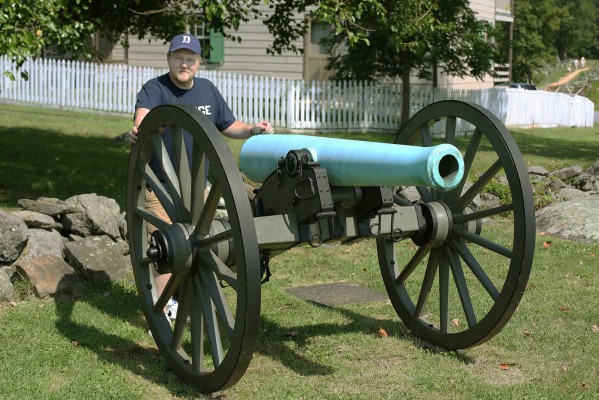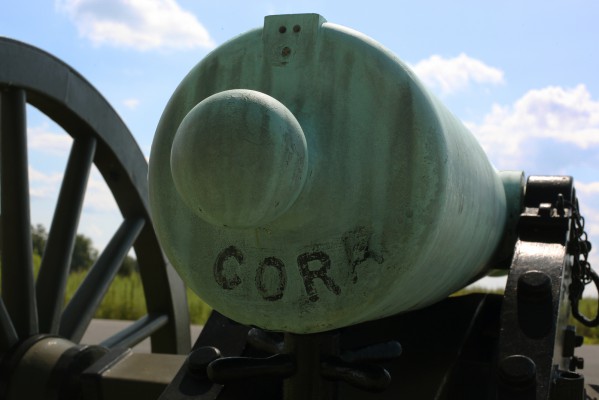Sitting in front of the headquarters of Daniel Sickles is a 12-pounder Napoleon. While the cannon was not present for the Battle of Gettysburg, it was used in the Civil War. ((George W. Newton, Silent Sentinels: A Reference Guide to the Artillery at Gettysburg (New York: Savas Beatie, 2005), 98.))

The cannon is unique, because it appears a soldier named the cannon “CORA” with paint on the back.

While we are almost positive that it was a Civil War era marking, we will know nothing else about it until some hidden letter in some archive turns up more details. However, we do know that soldiers often name their larger military equipment. Any World War II movie will demonstrate soldiers naming their tanks and planes, and even giving them personalities with cartoons and pinup girls. The CORA cannon, and others like it, demonstrate that this is not twentieth-century phenomenon. In fact, the practice of naming artillery pieces is as old as the medieval world.
Medieval Examples
In 1304, English King Edward I (r. 1272-1307) built a massive trebuchet outside Stirling Castle. When construction was almost complete, the defenders surrendered, but Edward did not accept until he was able to use the weapon for at least one day. ((Micheal Prestwich, War, Politics, and Finance Under Edward I (Totowa: New Jersey, 1972), 53.)) In the official records, there is a note that the English named the machine Warwolf. We have no remnants of Warwolf or any other trebuchet from the medieval period. However, we do know that it took five carpenters and an addition 50 laborers to build it. ((Jim Bradbury, The Medieval Siege
(Woodbridge: The Boydell Press, 1992), 268.))
With so much work put into a single machine, it seems almost natural to name it as we do ships nowadays. One modern historian points out that naming trebuchets was rare, at least in the official records. ((David Stewart Bachrach, “English Artillery 1189–1307: The Implications of Terminology,” English Historical Review 494 (2006): 1429.)) However, like the CORA cannon, it is probable that the English named their machines and kept the names out of the record. Still, at the same siege of Stirling, there are trebuchets mentioned by name in delivery records—Segrave, Vernay, Robynet, Forster and Gloucester. ((Bradbury 1992, 268.))
Naming siege equipment did not start or stop with the reign of Edward. During the Third Crusade (1189-1192), English King Richard I (r. 1189-1199) built a siege tower in Cyprus known as Malvoisin, which translates to “Bad Neighbor.” He later transported the tower to Acre and renamed it Malcousin, or “Bad Relation.” ((Ibid., 125.)) Naming machines was not confined to the English. The Franks built Malregard, a tower, at Antioch (1097-1098) during the First Crusade. ((Ibid., 110-111.)) When the Muslims besieged Acre for the last time (1291), they built their own siege engines known as Victorious and Furious. ((Ibid., 203.))
With the arrival of gunpowder, the naming of artillery appears more prevalent. When the Ottoman Turks besieged Constantinople (1453), they had a large array of cannons. The largest, named Basilica, weighed 1,600 pounds and it took 200 men and 60 oxen just to move it. ((Jack Kelly, Gunpowder: Alchemy, Bombards, & Pyrotechnics: The History of the Explosive that Change the World (New York: Basic Books, 2004), 51.)) Pope Pius II (p. 1458-1464) named two cannons after himself. Emperor Charles V (r. 1519-1556) named a battery The Twelve Apostles. ((Ibid., 68-69.)) The examples become endless as we move forward in time.
Again, we know nothing about the men who named CORA. It appears to be an affectionate name as opposed to Edward’s Warwolf, which was obviously meant to strike fear. Without more context, we cannot be certain if the men meant it as an inspiration, as the Muslim’s Victorious or as a religious reference, as with Charles’s The Twelve Apostles. CORA certainly had a personal feel, as the men operating the cannon put it in a spot where only they would see it. While there are unanswered questions, what we do know is naming military equipment, especially artillery, is an age-old practice in warfare.
